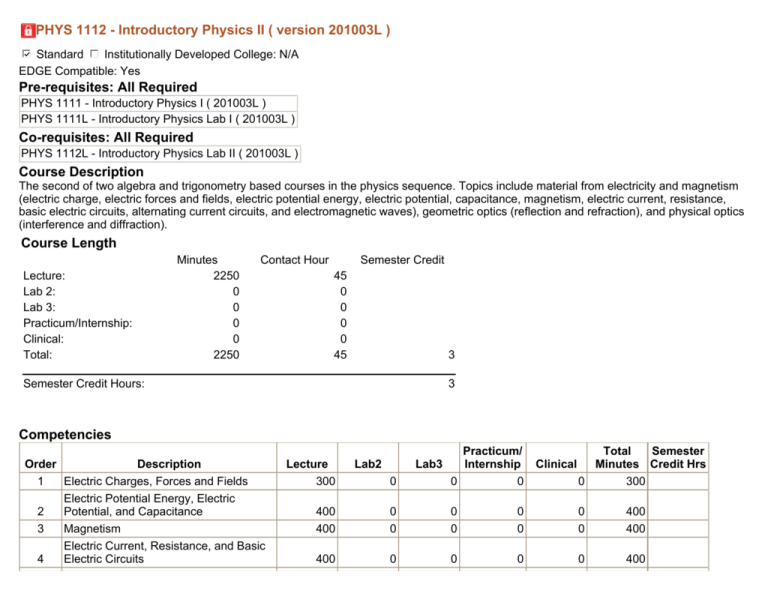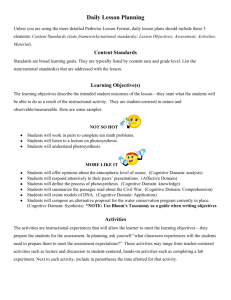
PHYS 1112 - Introductory Physics II ( version 201003L )
Standard Institutionally Developed College: N/A
EDGE Compatible: Yes
Pre-requisites: All Required PHYS 1111 - Introductory Physics I ( 201003L )
PHYS 1111L - Introductory Physics Lab I ( 201003L )
Co-requisites: All Required
PHYS 1112L - Introductory Physics Lab II ( 201003L )
Course Description
The second of two algebra and trigonometry based courses in the physics sequence. Topics include material from electricity and magnetism
(electric charge, electric forces and fields, electric potential energy, electric potential, capacitance, magnetism, electric current, resistance,
basic electric circuits, alternating current circuits, and electromagnetic waves), geometric optics (reflection and refraction), and physical optics
(interference and diffraction).
Course Length
Lecture:
Lab 2:
Lab 3:
Practicum/Internship:
Clinical:
Total:
Minutes
2250
0
0
0
0
2250
Contact Hour
Semester Credit
45
0
0
0
0
45
3
Semester Credit Hours:
3
Competencies
Order
Description
1
Electric Charges, Forces and Fields
Electric Potential Energy, Electric
2
Potential, and Capacitance
3
Magnetism
Electric Current, Resistance, and Basic
4
Electric Circuits
0
Practicum/
Internship
0
0
400
400
0
0
0
0
0
0
0
0
400
400
400
0
0
0
0
400
Lecture
300
Lab2
Lab3
Clinical
Total
Semester
Minutes Credit Hrs
0
300
Order
Description
5
Alternating Current Circuits
6
Electromagnetic Waves
7
Optics
8
Totals for Course PHYS 1112 Introductory Physics II ( version
201003L ):
Lecture
250
100
400
0
0
0
0
0
0
0
0
0
Practicum/
Internship
0
0
0
0
0
0
0
Lab2
2250
Lab3
Clinical
0
0
0
0
Total
Semester
Minutes Credit Hrs
250
100
400
0
0
2250
3
Learning Outcomes
Electric Charges, Forces and Fields
Order
1
2
3
4
5
6
7
8
9
Description
Distinguish between the two types of electric charge.
Describe the law of charges that operates between charged objects.
Understand and use the law of conservation of charge.
Distinguish between conductors and insulators.
Explain the operation of the electroscope.
Distinguish among charging by friction, conduction, induction, and polarization.
Understand Coulomb's law to calculate the electric force between charged particles.
Understand the definition of the electric field.
Plot electric field lines and calculate electric fields for simple charge distributions.
Learning
Domain
Cognitive
Cognitive
Cognitive
Cognitive
Cognitive
Cognitive
Cognitive
Cognitive
Cognitive
Level of
Learning
Analysis
Knowledge
Comprehension
Analysis
Comprehension
Analysis
Comprehension
Comprehension
Knowledge
Electric Potential Energy, Electric Potential, and Capacitance
Order
Description
1
Understand the concept of electric potential difference (voltage) and its relationship to electric
potential energy.
2
Calculate electric potential differences.
3
Explain what is meant by an equipotential surface.
4
Sketch equipotential surfaces for simple charge configurations.
Learning
Level of
Domain
Learning
Cognitive Comprehension
Cognitive Application
Cognitive Comprehension
Cognitive Knowledge
Order
5
6
7
8
9
10
11
Description
Explain the relationship between equipotential surfaces and electric fields.
Define capacitance and identify its units.
Calculate the charge, voltage, electric field, and energy storage for parallel-plate capacitors.
Understand the concept of dielectrics.
Calculate the charges, voltages, and energy storage of individual capacitors in series and
parallel configurations.
Find the equivalent capacitance of capacitors connected in series and in parallel.
Analyze capacitor networks that include both series and parallel arrangements.
Learning
Domain
Level of
Learning
Cognitive
Cognitive
Cognitive
Cognitive
Cognitive
Comprehension
Knowledge
Application
Comprehension
Application
Cognitive Knowledge
Cognitive Knowledge
Magnetism
Learning
Level of
Order
Description
Domain
Learning
1
Determine the force rule between magnetic poles.
Cognitive Application
2
Explain how the direction of a magnetic field is determined with a compass.
Cognitive Comprehension
3
Determine the magnitude and direction of the magnetic field produced by current carrying wires, Cognitive Application
loops and solenoids.
4
Use the right-hand rule to determine the direction of the magnetic field from the direction of the
Cognitive Application
current that produces it.
5
Define the magnetic field strength.
Cognitive Knowledge
6
Determine the magnetic force exerted by a magnetic field on a moving charged particle.
Cognitive Application
(Applications: Charged particles in magnetic fields.)
7
Calculate the magnetic force on a current-carrying wire, and the torque on a current-carrying
Cognitive Application
loop.
8
Explain the concept of the magnetic moment of a coil.
Cognitive Comprehension
9
Define magnetic flux.
Cognitive Knowledge
10 Explain how an induced EMF is created. Determine induced EMFs and currents.
Cognitive Comprehension
11 Understand the operation of electrical generators, and calculate the EMF produced by an AC
Cognitive Comprehension
generator.
12 Explain the origin of back EMF and its effect on the behavior of motors.
Cognitive Comprehension
13 Explain transformer action in terms of Faraday's Law.
Cognitive Comprehension
14 Calculate the output of step-up and step-down transformers.
Cognitive Application
Order
Description
15 Understand the importance of transformers in electric energy delivery systems.
Learning
Level of
Domain
Learning
Cognitive Comprehension
Electric Current, Resistance, and Basic Electric Circuits
Order
1
2
3
4
5
6
7
8
9
10
11
12
13
14
15
16
17
18
Description
Understand the properties of a battery.
Explain how a battery produces a direct current in a circuit.
Explain various circuit symbols for sketching schematic circuit diagrams.
Define electric current.
Distinguish between electron flow and conventional current.
Explain the concept of drift velocity and electric energy transmission.
Define electric resistance.
Explain what is meant by ohmic resistor.
Determine the factors that determine resistance.
Define electric power.
Calculate the power delivery of simple electric circuits.
The equivalent resistance of resistors in series, parallel, and series-parallel combinations.
Use equivalent resistances to analyze simple circuits.
Understand the physical principles that underlie Kirchhoff's circuit rules. Apply these rules in the
analysis of actual circuits.
Explain how household circuits are wired.
Explain the principles that govern electrical safety devices.
Describe the charging and discharging of a capacitor through a resistor.
Calculate the current and voltage at specific times during these processes.
Learning
Domain
Cognitive
Cognitive
Cognitive
Cognitive
Cognitive
Cognitive
Cognitive
Cognitive
Cognitive
Cognitive
Cognitive
Cognitive
Cognitive
Cognitive
Level of
Learning
Comprehension
Comprehension
Comprehension
Knowledge
Analysis
Comprehension
Knowledge
Comprehension
Application
Knowledge
Application
Knowledge
Application
Comprehension
Cognitive
Cognitive
Cognitive
Cognitive
Comprehension
Comprehension
Knowledge
Application
Alternating Current Circuits
Order
Description
1
Specify how voltage, current, and power vary with time in an AC circuit.
2
Understand the concepts of rms and peak values.
Learning
Level of
Domain
Learning
Cognitive Knowledge
Cognitive Comprehension
Order
3
4
5
6
7
8
9
Description
Explain how resistors respond under AC conditions.
Explain the behavior of capacitors in AC circuits.
Calculate the capacitive reactance.
Explain the behavior of inductors in AC circuits.
Calculate the inductive reactance.
Calculate the reactance, impedance, current, voltage, power factor, power, and phase angle in
AC circuits.
Explain the concept of resonance in AC circuits.
Learning
Domain
Cognitive
Cognitive
Cognitive
Cognitive
Cognitive
Cognitive
Level of
Learning
Comprehension
Comprehension
Application
Comprehension
Application
Application
Cognitive Comprehension
Electromagnetic Waves
Order
Description
1
Recognize Maxwell's equations.
2
Explain the relationship between the frequency, wavelength, and speed of electromagnetic
waves.
3
Explain the transport of energy by electromagnetic waves.
4
List the various types of electromagnetic waves according to their respective wavelengths.
Learning
Level of
Domain
Learning
Cognitive Analysis
Cognitive Comprehension
Cognitive Comprehension
Cognitive Knowledge
Optics
Order
1
2
3
4
5
6
7
Description
Determine the speed of light in various media.
Demonstrate knowledge of the dual nature of light.
Explain reflection and image formation by plane and spherical mirrors.
Explain refraction and image formation by lenses.
Solve problems using Snell's law.
Explain double slit interference patterns.
Explain the behavior of diffraction gratings.
References
Learning
Domain
Cognitive
Cognitive
Cognitive
Cognitive
Cognitive
Cognitive
Cognitive
Level of
Learning
Application
Application
Comprehension
Comprehension
Application
Comprehension
Comprehension
Order
Reference Type
1
Book with Author(s)
Listed
2
Book with Author(s)
Listed
3
Book with Author(s)
Listed
4
Book with Author(s)
Listed
5
Book with Author(s)
Listed
6
Book with Author(s)
Listed
7
Book with Author(s)
Listed
8
Book with Author(s)
Listed
9
Professional Web
Site
Description
Giambattista, A., & et al.. (2010). College physics with an integrated approach to forces and
kinematics. (3rd). New York, NY: McGraw Hill.
Christian, W. & Belloni, M.. (2004). Physlet physics-interactive illustrations, explorations, and problems
for introductory physics. (1st). Upper Saddle River, NJ: Pearson / Prentice Hall.
Cutnell, J. & Johnson, K.. (2006). Physics. (7th). New York, NY: John Wiley & Sons.
Giancoli, D.. (2004). Physics, principles and applications. (6th). Upper Saddle River, NJ: Pearson /
Prentice Hall.
O'Kuma, T. & et al.. (2004). Ranking task exercises in physics. (Student edition). Upper Saddle River,
NJ: Pearson / Prentice Hall.
O'Kuma, T. & et al.. (2006). E&M TIPERs: Electricity and magnetism tasks. (1st). Upper Saddle River,
NJ: Pearson / Prentice Hall.
Serway, R. & Faughn, J. & Vuille, C.. (2009). College physics. (8th). Belmont, CA: Brooks / Cole.
Wilson, J. & et al.. (2009). College physics with mastering physics. (7th). ?: Pearson / Addison
Wesley.
North Carolina State University: Advanced Instructional Systems, Inc.. (1997-on going). WebAssign: A
web-based assessment system providing homework and test delivery, collection, grading, and
recording services. Retrieved ?, from http://webassign.net








